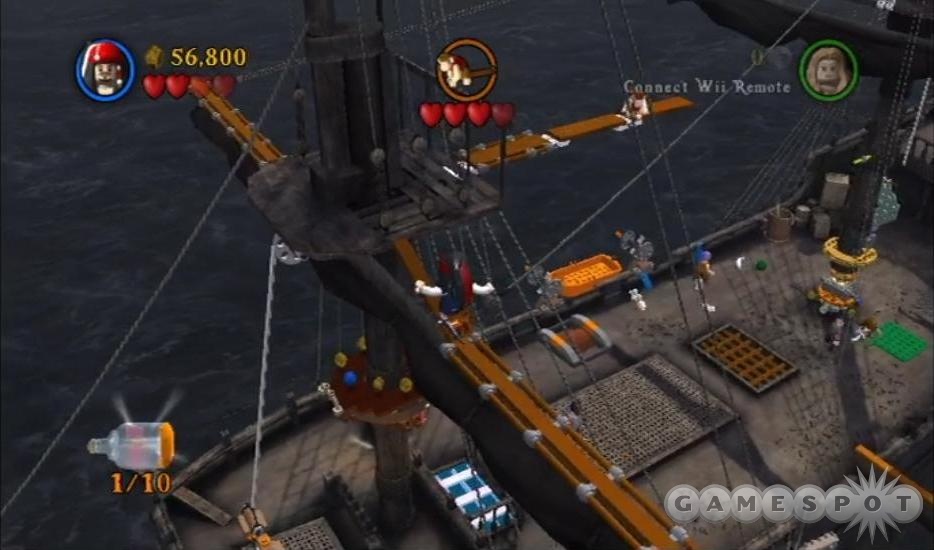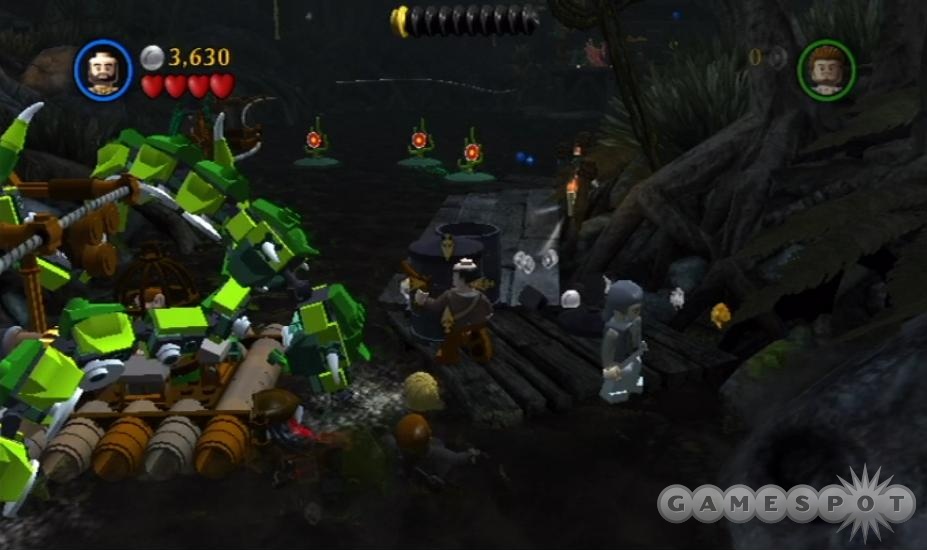Charm. It's an elusive virtue, but developer Traveller's Tales loads its Lego games with so much of the stuff that it's as if it mines it from an endless source. Lego Pirates of the Caribbean is yet another delightful take on cinematic subject matter, and it's bound to get even the most jaded players to guffaw at its adorable visual storytelling. Nevertheless, it's a rare game that survives on charm alone, and Lego Pirates suffers from the same sloppiness that seeped into the recent Lego Star Wars III: The Clone Wars. Inconsistent visual cues all too often suck out the fun, bringing the swashbuckling to a frequent standstill while you roam about figuring out what do to next. Meanwhile, inexact platforming and respawning enemies turn the easygoing merriment into a frustrating slog. Nevertheless, the joys of these games are still strong. Franchise fans expect lots of Lego bits to collect and extra goodies to unlock, and Lego Pirates doesn't disappoint in this regard. The game is as colorful as a tower of Lego bricks, but unfortunately, it's not much sturdier.
At least, its heart is in the right place. Like previous games, Lego Pirates of the Caribbean is a wordless retelling of (mostly) known entertainment. In this case, the Pirates of the Caribbean films are the inspiration, including the yet-unreleased fourth installment, subtitled "On Stranger Tides." So even if you're the world's biggest Johnny Depp or Orlando Bloom fan, you may not always know exactly what's going on in the last of these four included adventures, but the game does a fine enough job of giving you the gist. Besides, what happens isn't as important as how it happens. Lego Pirates eschews dialogue in favor of adorable details that are sure to put a smile on your face. When two characters walk the plank, they remain suspended in midair for a moment before plunging into the sea. Monkeys and pigs are given prominent comedic roles. When engaging enemies as flamboyant pirate Jack Sparrow, you may drop a banana peel for them to slip on or bonk them on the head with a bottle. Almost every cutscene has some silly surprise or another, and the breezy winks and nods are the most compelling reason to push through to the end.
The continuous supply of Lego studs that you accumulate as you break every brick you can also offers another reason for pushing to the end. The series is at its best when these bits rain down on you as you smash, reassemble, and smash again. You do so either alone or with a friend in local cooperative play. (Once again, online co-op is irritatingly absent.) However, you don't just have a single AI or human-controlled buddy in tow in many of the levels; rather, you might have a party of a half-dozen or even more, and you can switch among them by holding down a button and selecting a character from a wheel. You do this often to solve many of Lego Pirates' puzzles. Only certain characters can repair broken objects, while "ladies" (as the game calls its female characters) are the only ones who can double jump. Having all these characters to control at any given time is an interesting idea that lends some diversity, but it doesn't always work out all that well in practice. For one, the AI is still as dumb as a box of Lego bricks, and having an entire company of buffoons following you around can be aggravating. For instance, you might want to navigate a series of narrow ledges, only to have three companions crowd you off of it--possibly into a toxic swamp.

For another, you need to remember which party member has which special skill; this isn't always easy when dealing with lesser characters from the films. This issue is made all the more frustrating when the game leaves you to figure out those skills on your own. For instance, only one member of your party might be strong enough to pull a particular handle, but you only discover this through trial and error or possibly after wandering around for a few minutes wondering what to do next. This sort of event happens far too often in Lego Pirates of the Caribbean. Sometimes, key objects are identified, indicating that you can interact with them. Other times, objects you don't need or have already used are highlighted, but important ones are not. Or, perhaps, an important location is revealed only when you take control of a particular character. These maddening inconsistencies cause you to roam around, jumping in beached canoes and picking up rocks, only to discover that you just needed to grab on to a nondescript rope. Busy foregrounds might also obscure interactive objects, which adds to the confusion. By only half-communicating its own rules and then frequently breaking them, Lego Pirates comes across as somewhat careless.
Other little things further drag the game down. You might want to solve the puzzle at hand, but endlessly respawning enemies end up getting in the way. Jumping on a lily pad propels you so far upward that the pad you must land on drops beneath the view of the camera, which turns three simple leaps into unnecessary aggravation. Yet, for all the frustrations, there are successes worth celebrating, too. A chapter in which you enter a cylindrical cage and roll over everything in your path is great fun, especially in co-op play. A boss fight on a giant wheel is equally enjoyable, and it is further accentuated by the gorgeous palm trees in the background that rush past your view. That scene is a great example of Lego Pirates' wonderful look, which contrasts its blocky characters and smashable objects with lush, semirealistic environments. This technique is put to particularly good use in the final adventure, in which you glimpse the streets of London from dizzying heights above. Some cutscenes break this visual mold by presenting 2D flashbacks with a touch of paper-craft styling. These look absolutely terrific as well.

Even Lego: Pirates of the Caribbean's hub world tarnishes its delights with unnecessary annoyances. To wit: you discover there a miraculous contraption that allows you to turn day into night, and vice versa. But such joys are dampened when you want to unlock a new character for free play. You see, you don't do this from a menu, but rather, you must wander around and hope to run into characters you have yet to purchase. (The finicky button prompt that disappears when they wander out of range further clutters the process.) And so it goes in Lego Pirates, which is a huge pleasure one moment and a major nuisance the next. This entry may have the spirit of a peg-legged pirate, but it has the same limp, too.